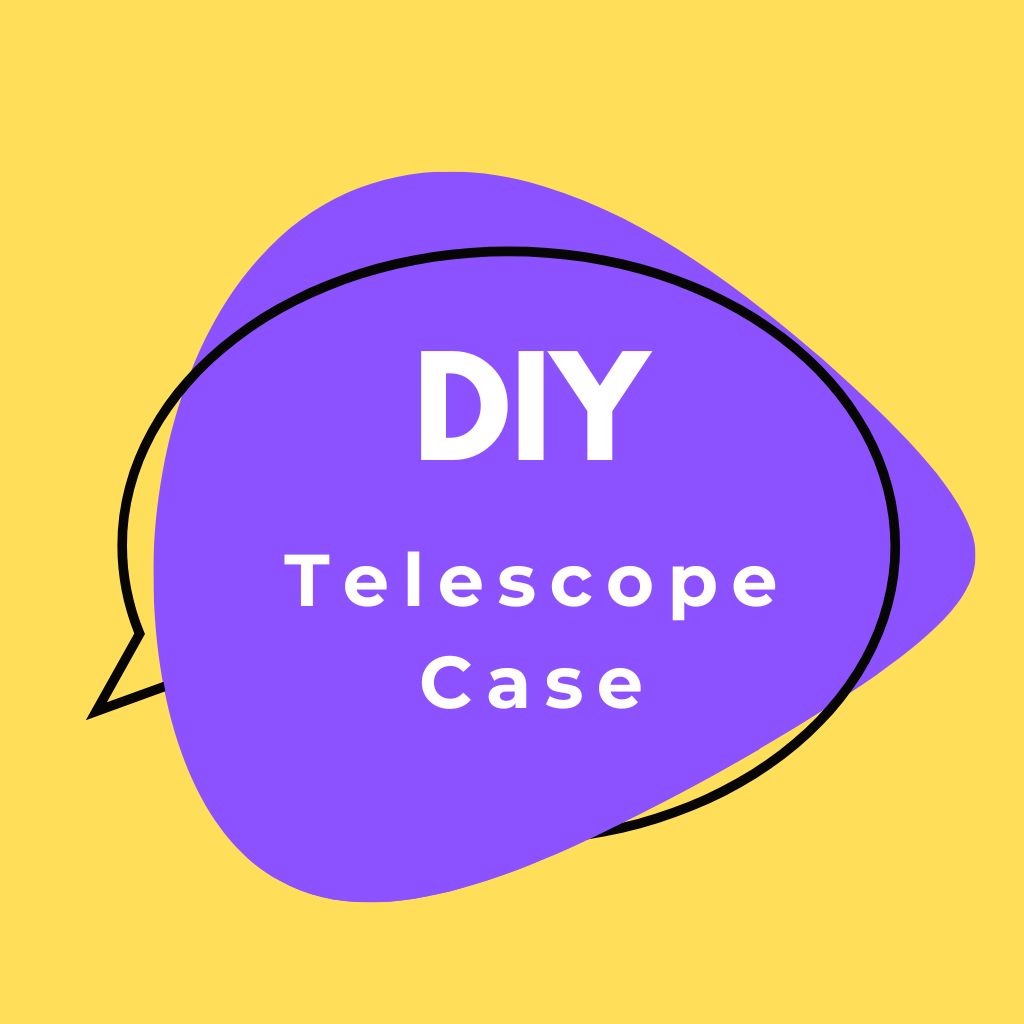This site contains affiliate links to products. I may receive a commission for purchases made through these links.
With a bit of time, patience, and the right materials, you can build a sturdy, tailor-made case that fits your telescope like a glove. Not to mention, it’s a great way to show off your DIY skills!
In this article, I’ll guide you through the process step-by-step. From gathering materials to assembling the case, I’ve got you covered. So, let’s get started and ensure your telescope’s safe travels, whether you’re stargazing in your backyard or trekking to a remote star party.
Materials Needed
To start off, it’s important to gather all the necessary materials before beginning the creation of your own custom telescope case. This ensures that the building process goes smoothly, and you won’t find yourself in situations where you have to stop work to go out and buy something you’ve missed.
For the outer case, a hard case is ideal, especially if you’re planning to travel with the telescope. Polycarbonate cases are a great choice due to their durability and lightweight properties. Depending on the size of your telescope, you’ll need to choose the size of the case accordingly.
Now let’s look at what you’ll need for the interior of the case. The internal lining should provide cushioning to the telescope and ensure it remains safe and secure. High-density foam is an excellent option as it’s sturdy yet flexible, effectively absorbing shocks and impacts. This foam can usually be bought in sheets, and then cut to fit the dimensions of your case.
Securing the telescope within the case is vital, so you’ll require Velcro straps for this. They’re simple to use, adjustable, and most importantly, they hold the telescope securely in place.
Lastly, you’ll need basic tools like a measuring tape to take accurate measurements of your telescope, a utility knife to cut the foam, and glue to adhere the foam to the case.
To sum it up, here’s a quick rundown of the material list:
- Polycarbonate case
- High-density foam sheets
- Velcro straps
- Measuring tape
- Utility knife
- Glue
Once you have all these materials in hand, you’re ready to move to the next phase: designing the outline of your telescope case. This process is crucial as it’s where you’ll define the case structure to accommodate your telescope perfectly—ensuring it’s snug, safe, and secure for all your stargazing adventures.
Measuring and Planning
Now that we have all our materials laid out, it’s time tom move on to the Measuring and Planning phase of our telescope case project. This is arguably one of the most critical stages. It’s here that we’ll determine the exact dimensions, and design the internals of our case to ensure our telescope fits perfectly.
First let’s start by measuring our telescope. It’s important to measure your telescope’s length, width, and height accurately. Take the bulkier parts into account, and always remember to add a little extra for safety. Record these measurements, as we’ll use them later for the exact cutting of the foam.
After measuring, it’s crucial to plan the layout for our case. We need to make sure our telescope fits comfortably, with adequate space left for the other essential equipment such as lenses, eyepieces, and cleaners. Always factor in your most used accessories and make sure you’ve got designated spaces for them within your case design.
Finally, consider how the telescope and its accessories will sit within the case. This could include things like placing the eyepieces near the eyepiece holder or ensuring space for a star finder. Remember that each telescope is unique, and what works for one model might not work as well for another.
Here’s a simple rundown of the measurements to consider:
| Telescope Parts | Measurements |
|---|---|
| Length | xx cm |
| Width | xx cm |
| Height | xx cm |
And for the equipment layout:
- Space for telescope
- Designated spots for lenses
- Areas for eyepieces
- Room for cleaning equipment
- Potential placement for a star finder or other accessories
When it comes to designing your telescope case, customization becomes key. Each telescope model is unique, so there’s no one-size-fits-all solution. The right design will depend on your specific telescope’s dimensions and the accessories you intend to carry.
Choosing the Right Design
Think carefully about how you’re going to store more than just your telescope. One key aspect is placing your must-have accessories. Items such as lenses, filters, or star charts might need their own compartments. The design should allow enough space to safely nestle these items while optimizing the available space. Pockets and compartments might be a good idea, depending on how many accessories you carry.
For heavier items, like tripods, you might want a special section or maybe even attach them externally.
Importance of Materials
The type of material plays a decisive role in the longevity, protection, and carrying comfort of your telescope case. Rigid foam, hard plastic cases are great for heavy-duty protection but add to the overall weight. Soft materials like nylon, on the other hand, are lightweight and easier to carry.
Consider the environment and conditions you will be using your telescope in. If you’re in a wet or dusty environment often, a case that’s water and dust resistant would be wise.
Dimensions Matter
Remember, size matters. A common mistake I see is people selecting too small or too large a case design. Too small, and you risk damaging your precious equipment. Too big, your telescope and accessories might bounce around, leading to potential misalignment.
Here is a simple rundown of the measurements to consider:
| Measurement | Importance |
|---|---|
| Telescope’s Length | Tells you the minimum length your case should be |
| Telescope’s Diameter | Determines the width of your case |
| Accessory size | Helps you design compartments, pockets |
The right design factor in your specific telescope type, the accessories you carry, the environment you usually use it in, and of course, your personal preferences.
Cutting and Preparing Materials
Once you’ve identified your needs and selected your design, it’s time to get your hands dirty and start cutting and preparing the materials for your telescope case.
Strong and durable materials are necessary for the outer shell. Typically, plywood or hard plastic is used as they are both sturdy and lightweight. Keep in mind that it’s essential to cut these materials with precision. It’s the dimensions of your telescope that dictate the size of these cutouts, so measure twice, cut once is a mantra you’ll want to live by.
| Material | Properties |
|---|---|
| Plywood | Strong, resilient, lightweight |
| Hard Plastic | Durable, lightweight, waterproof |
Inner lining should be soft and cushiony, this will protect your telescope and accessories from impacts and scratches. Foam is commonly used for this purpose. Remember, this soft layer needs to be cut to the same dimensions as the outer shell, with proper spaces made for your telescope and accessories.
Deciding on the right hinge and latch system for your case is also crucial. You want to ensure it’s sturdy and fits your build perfectly.
Now that you have your materials cut and prepared, don’t forget about the finishing touches. Sanding is important to remove any burrs or irregular edges from your cutouts.
Lastly, make sure to consider any weatherproofing treatment necessary for your case, especially if you plan on using it outside or in harsh environments.
Assembling the Case or Bag
Now that you’ve cut and prepared your materials, we’re on to the next exciting step: assembling your telescope case or bag. Don’t rush this process – precision is key here. It’s vital to ensure a secure, well-fitted casing that will adequately store and protect your telescope.
First step: join your outer shell materials. If you’re using plywood, a sturdy wood glue can do the trick. For plastic cases though, a polyethylene adhesive is a go-to choice. Remember to allow sufficient time for the adhesive to cure. Don’t skip this! It’s an essential part of the process, providing the strength and durability that characterizes a high-quality telescope case.
Let’s progress to the inner lining. This is where you attach the foam lining to the inner surface of the case. A layer of contact adhesive applied to both surfaces should do the job. It’s crucial to make sure every inch of the foam aligns perfectly with the inner surface. An improperly lined case may cause damage to your telescope, rendering the entire exercise futile.
Next, let’s head on to the hinge and latch installation. Align your hinges with the edge of the case; most hinges will come with an installation guide you can follow. The type of screws used here hinges on the material you chose for your outer shell. For example, self-tapping screws work best with hard plastic. Please verify what type of fastener is most compatible with your chosen material.
Finally, sand the case and consider a weatherproofing treatment. A well-sanded case not only looks professional but also lessens the risk of injury due to splinters or rough edges. Whether or not to apply a weatherproofing treatment to your case is up to you.
In the end, knowing how to build your telescope case isn’t just about housing your telescope. It’s about crafting a secure, high-quality storage unit that extends your telescope’s lifespan. Stick with the plan, and you’ll have a case that’s a perfect fit, not just for your telescope, but for you as well. The journey continues, so stay tuned for more steps.
Adding Protective Features
After attaching the outer shell and installing the inner lining, it’s time to focus on adding a few protective features to your telescope case. Remember, protection is key when it comes to these sensitive devices.
Performance hinges and reliable locks are important, but they won’t safeguard your telescope against minor bumps and drops. For this, you’ll need added cushioning material. Shock-absorbing foam is a popular choice among many DIY telescope case builders. Its firm yet flexible nature provides excellent protective padding.
Slabs of foam can be cut to size and securely installed into the base, lid and sides of your case – forming a snug fit for your telescope and vital accessories. Dense foam slab materials such as Polyethylene or Polyurethane foam can offer superior protection.
While choosing foam, consider two factors, density and thickness.
| Foam | Density (lb/cubic ft.) | Ideal Thickness (inches) |
|---|---|---|
| 1. Polyethylene | 2.2 to 6.0 | 1 to 2 |
| 2. Polyurethane | 1.5 to 3.0 | 1.5 to 3.0 |
Remember, improperly installed foam might lead to unwanted movement of your telescope within the case, which could potentially be damaging.
All of our effort till now in sanding the case, considering the weatherproofing treatment, and painstakingly installing the hinges and locks can all go in vain if the protective measures aren’t up to the mark. That being said, our journey in building a telescope case or bag doesn’t end here – numerous other steps are yet to be uncovered and explored. Thus, always strive for perfection while following each part of the process because the objective is not just to build a case, but rather to build a secure, robust, and high-quality storage unit for your telescope.
Finishing Touches
The journey doesn’t end with padding. There’s more craftsmanship involved to ensure our telescope has the best home possible. So, let’s move forward to discussing the final touches to make this telescope case an all-rounder.
One area we need to focus on is seams and edges. We must reinforce these parts of the case because they’re subjected to excessive wear and tear. When working on these, it’s important to use the right type, thickness, and sewing technique for the material we’re working with. A case created with strong seams and edges will be harder to rip apart and will consistently hold its shape.
Let’s tackle the zippers and other fasteners. Zippers can be pesky little things. The moment they break or lose teeth, they become ineffective. I recommend using high-quality metal zippers. They’re sturdy, reliable, and can stand the test of time. Also, don’t forget to provide a cover or flap over the zipper – it helps in keeping out dust and moisture.
Other fasteners such as buckles or clasps are also needed for extra security. It’s always a good idea to include these, especially if you’re planning to store additional accessories with your telescope. Having more than one securing mechanism maintains the snug fit for your precious gear and prevents accidental spills when transporting or handling it.
Given our objective is a secure and robust storage unit, paying attention to these minute details can make a considerable influence in the performance and life of our telescope case. It’s all about giving the telescope a home that’s durable and environmentally controlled. I’ll be back with more insights into this DIY project. Until then, keep going! We’re halfway to our goal.
Conclusion
I’ve walked you through the steps to build your own telescope case or bag. We’ve covered the importance of strong seams, edges and the use of high-quality metal zippers. It’s clear that these elements are key to ensuring your telescope’s protection. Remember, the journey doesn’t end here. It’s now up to you to put this knowledge into action.
With patience and attention to detail, you’ll have a sturdy, secure storage unit for your telescope. So, get started and enjoy the peace of mind that comes with knowing your telescope is well protected.







